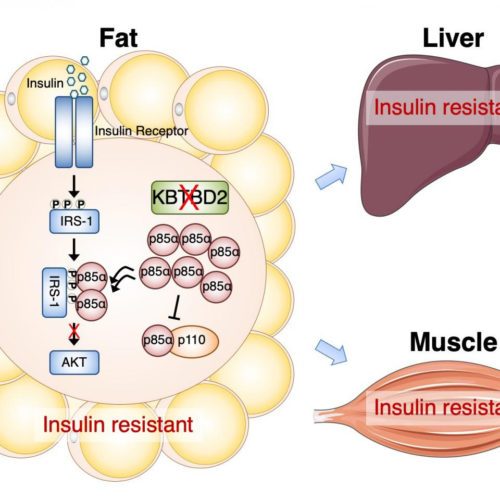by University of Wisconsin-Madison Best vitelliform macular degeneration, or Best disease, is an inherited eye condition that typically leads to blindness over the course of a few decades. The disease can be caused by more than two hundred mutations in the BEST1 gene. The researchers were able to correct the disease in stem cells from...
Category: <span>Genetics</span>
ENCODE 3 project details the inner workings of the human and mouse genome
by NIH/National Human Genome Research Institute The Encyclopedia of DNA Elements (ENCODE) Project is a worldwide effort to understand how the human genome functions. With the completion of its latest phase, the ENCODE Project has added millions of candidate DNA “switches” from the human and mouse genomes that appear to regulate when and where genes...
Talbot helps ID muscle gene that, when altered, causes joint disease
UNIVERSITY OF MAINE Jared Talbot is part of a 32-member international research team that identified a gene that, when altered, can cause bent fingers and toes, clubfoot, scoliosis, and short stature. The team discovered that partial loss of the protein coding gene MYLPF (myosin light chain, phosphorylatable, fast skeletal muscle) results in a disorder called...
Gene in fat plays key role in insulin resistance
Developing a better understanding of KBTBD2 could have implications for Type 2 diabetes, UTSW researchers say UT SOUTHWESTERN MEDICAL CENTER THE ILLUSTRATION SHOWS THE IDENTIFICATION OF KBTBD2 AS A KEY GENE IN THE MAINTENANCE OF WHOLE-BODY INSULIN SENSITIVITY THROUGH ITS ROLE IN FAT. LOSS OF KBTBD2 LEADS TO THE ACCUMULATION… view more CREDIT: UT SOUTHWESTERN...
Study shows genetic markers are useful in predicting osteoporotic fracture risk
Findings hold potential for cost savings while improving efficiency of screening HEBREW SENIORLIFE HINDA AND ARTHUR MARCUS INSTITUTE FOR AGING RESEARCH A new study shows that genetic pre-screening could reduce the number of screening tests needed to identify individuals at risk for osteoporotic fractures. Douglas P. Kiel, M.D., M.P.H.,director of the Musculoskeletal Research Center in...
Prostate cancer metastasis linked to revival of dormant molecular program
by Dana-Farber Cancer Institute When prostate cancer progresses to a more-dangerous metastatic state, it does so by resurrecting dormant molecular mechanisms that had guided the fetal development of the prostate gland but had been subsequently switched off, say scientists from Dana-Farber Cancer Institute. The study, an international collaboration with The Netherlands Cancer Institute, was published...
Scientists ID gene responsible for deadly glioblastoma
UNIVERSITY OF VIRGINIA HEALTH SYSTEM THE DISCOVERY OF THE ONCOGENE RESPONSIBLE FOR GLIOBLASTOMA COULD BE THE BRAIN TUMOR’S ACHILLES’ HEEL, SAYS HUI LI, PHD, OF THE UNIVERSITY OF VIRGINIA SCHOOL OF MEDICINE AND THE UVA… view more CREDIT: UVA HEALTH Scientists have identified an oncogene (a cancer-causing gene) responsible for glioblastoma, the deadliest brain tumor....
New molecular tool precisely edits mitochondrial DNA
UW microbiologists discovered a bacterial toxin that, when engineered, is a key part of a gene editor that can make single-base changes in human mitochondria. The genome in mitochondria — the cell’s energy-producing organelles — is involved in disease and key biological functions, and the ability to precisely alter this DNA would allow scientists to...
Genetic editing milestone in mouse model of Rett Syndrome
Editing technique repairs mutant MeCP2 RNA and restores MeCP2 protein function RETT SYNDROME RESEARCH TRUST LEAD AUTHOR, JOHN SINNAMON, AND PRINCIPAL INVESTIGATOR, GAIL MANDEL. view more CREDIT: RETT SYNDROME RESEARCH TRUST A genomic error that causes Rett Syndrome, a serious lifelong neurological disorder, can be corrected in the brains of mice by rewriting the genetic...
Researchers discover potential treatment for rare degenerative disease
by Yale University Yale pharmacology professor Barbara Ehrlich and her team have uncovered a mechanism driving a rare, lethal disease called Wolfram Syndrome and also a potential treatment. Their findings appear in the July 6 edition of Proceedings of the National Academy of Sciences. Wolfram Syndrome—a progressive degenerative disease that affects about one in 500,000...







